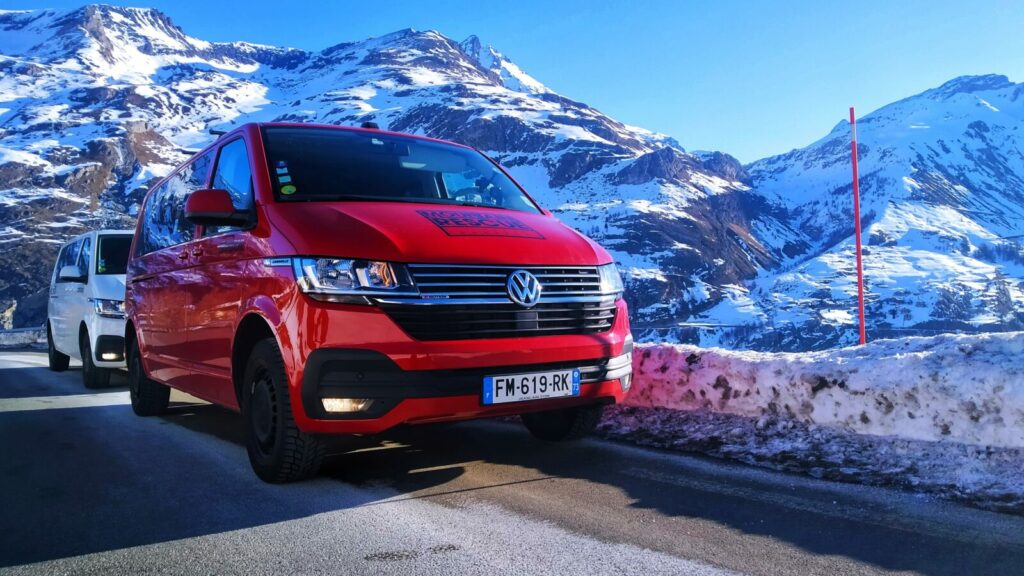
I’ve lived in Savoie and operated a ski transfer business in the French Alps for over 15 years now. There are always random events, acts of God that keep me and the team on our toes over every winter. We’ve learned to always be prepared for the unexpected.
Driving to the French Alps is not for the faint-hearted. Winter seasons gone by have seen massive boulders falling onto roads, traffic so bad due to intense snowfalls that people had to sleep in emergency accommodation or even spend the night in their cars.
With more and more people on the roads and the weather getting increasingly extreme, getting caught out in the Alpine environment is becoming more frequent.
Conditions can get hairy up here, and even in the foothills it’s crucial to know what you’re getting into before it’s too late.
I hope this guide helps you stay on top of the latest regulations for winter driving equipment, get your car Alpine-ready and time your travel in and out of the mountains to avoid the worst of the Saturday traffic.

Getting Your Car Ready
Getting your vehicle prepped for winter driving is essential for a trip to the French Alps. Here’s what you need to check before you head up the mountain—all of these issues are exacerbated after a week of parking.
Battery Check
Make sure your battery is up to scratch. Temperatures drop dramatically, especially at night, causing batteries to struggle. The last thing you want is to be stranded in a freezing car park at altitude.
Wipers and Screen Wash
Check your wipers are in good condition and that your windscreen wash is fully loaded with the best winter-grade antifreeze go for -40°C if you can get it. You’ll be using your wipers constantly in snow and slush, so make sure they’re up to the job.
Engine Antifreeze
Check your engine antifreeze as well. It’s easy to forget, but if your vehicle was last serviced during the summer, it may not be able to cope with the drop in temperatures during your Alps trip.
Diesel Fuel Additives
You might also want to consider adding an additive to your diesel car. Diesel fuel additives are crucial in very cold weather, and if you fuel up before you hit the Alps, some stations won’t have added this to the fuel.
I’ve experienced this myself. I left several vans sitting around pre-winter with summer fuel in them. A sudden drop in temperature at 1,400 metres and I had three vehicles with frozen fuel. When you start the car, you can hear the fuel pump screaming—this is your sign you have a problem. Turn off the car immediately before you cause damage.
The cold causes the diesel to gel and clog your fuel filter and fuel lines, stopping it from reaching your engine. If you’re lucky and the vehicles are in a sunny spot, you can leave them to thaw out. Worst case? You’ll need a trip to the garage for replacement filters, possibly a new fuel pump, and maybe even damage to your fuel injectors.
In my case, my VW Caravelles had to have fuel filters replaced, one fuel pump fitted, and the engine management light reset. So it’s worth taking this seriously.
Prepping Electric Vehicles
This year we bought our first electric vehicle for the fleet, so this is new territory for me. But certainly, planning your charging stops has to be top of the agenda.
Charging at the foot of the mountain would be a good idea as well, but don’t leave it too late. There are definitely fewer and fewer options the closer you get to our neck of the woods in the Tarentaise valley.
I’d also recommend downloading offline maps, just in case.
Book your resort parking undercover. Keep that battery as close to a normal temperature as possible.
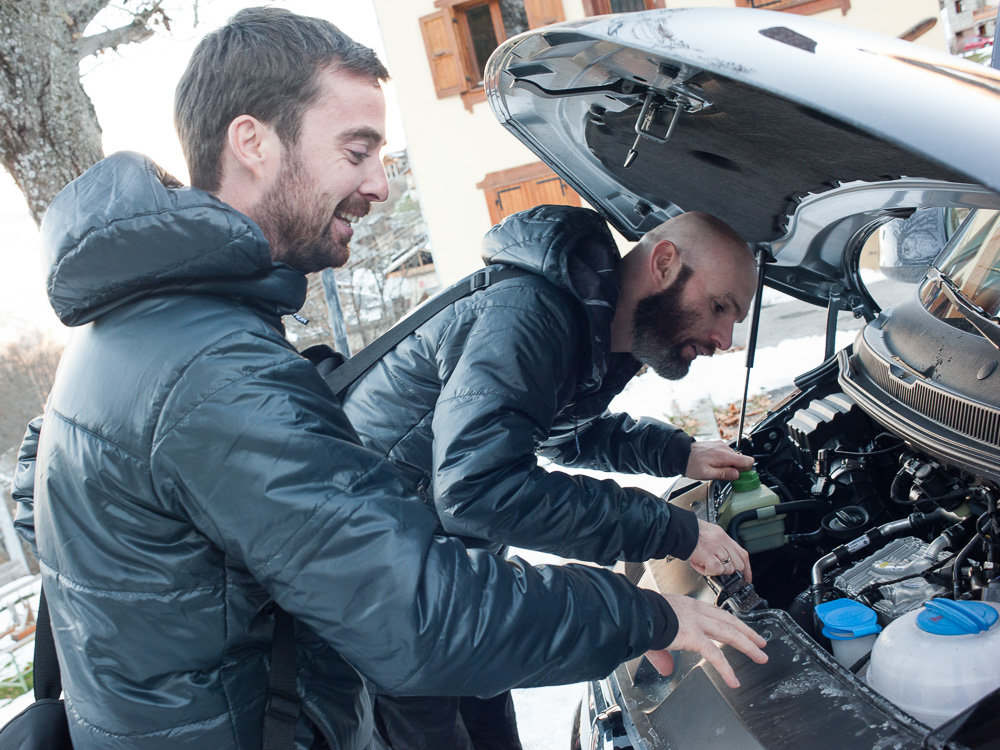
Winter Tyres: The Mountain Law
France’s Mountain Law requires specific winter equipment in 48 mountainous departments, with fines of up to €135 for non-compliance.
Approved Equipment Options:
All-Season Tyres Suitable for areas with occasional snow. Must display 3PMSF or M+S symbols. Ideal for holidaymakers and those living in lower elevations who encounter snow only a few weeks per year. Good balance of performance and affordability.
Winter Tyres Essential for mountain residents and those in high-altitude areas with extended snow periods. Provide superior grip on ice and snow. Should be switched seasonally with summer tyres for optimal performance and safety year-round.
Snow Chains Provide maximum traction on heavily snowed roads. Speed limited to 50 km/h. Must be installed roadside, which can be difficult in storms. A practical backup option for holidaymakers who primarily use all-season tyres.
Snow Socks Lighter and easier to install than chains. Also limited to 50 km/h. Best for low-gradient mountain roads. Popular with occasional mountain visitors due to their convenience and compact storage.
Critical Update: As of 1 November 2024, only tyres with the 3PMSF (Three Peak Mountain Snowflake) symbol are compliant. Tyres with only M+S marking are no longer accepted and must be replaced.
Penalties: Driving without proper equipment results in fines of up to €135. Vehicles must have either winter/all-season tyres installed, or chains/socks in the boot.
See more details here: https://www.loimontagne.info/departements/savoie-73
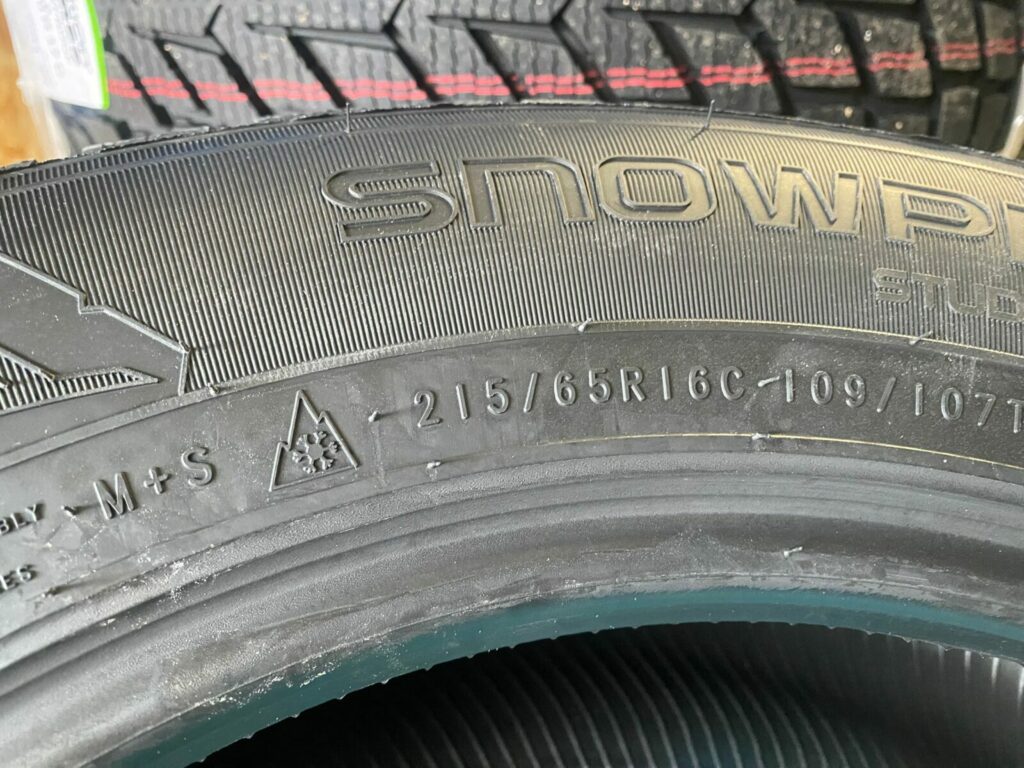
What Exactly Are Winter Tyres?
Driving to the French Alps this winter you’re going to need them. Winter tyres are, surprise surprise, specifically designed for cold weather driving. They’re made from a softer rubber compound that stays flexible when temperatures drop, giving you grip even when summer tyres turn hard and slippery. The tread pattern has deeper grooves and thousands of tiny slits called sipes that bite into snow and ice.
When you’re buying them, look for the Three Peak Mountain Snowflake (3PMSF) symbol—it’s a pictogram of a mountain with a snowflake inside. This symbol is your golden ticket: it’ll get you up the mountain and keep the gendarmes happy.
The old M+S (Mud and Snow) marking used to be acceptable, but those days are done.
Snow Chains
In the good old days, you could rock up with summer tyres and a set of snow chains or socks in the boot, and off you went.
Well, sort of. Our drivers regularly encounter people late at night, swerving across the road and desperately trying to inch their way uphill because they haven’t bothered or cant fit their chains. It’s not a pretty sight.
Snow chains become mandatory when you see the B26 road sign—that’s a tyre with chains on a blue background. You’ll typically see these during heavy snowfall or on particularly steep mountain roads.
How Snow Chains Work
Once fitted, snow chains work like a charm. They wrap around the tyre, creating a super-grippy metal addition to your wheel. The metal links bite into the snow and ice, creating channels that help expel the snow from underneath. Think of them as giving your tyres teeth that can grip even the iciest surfaces.
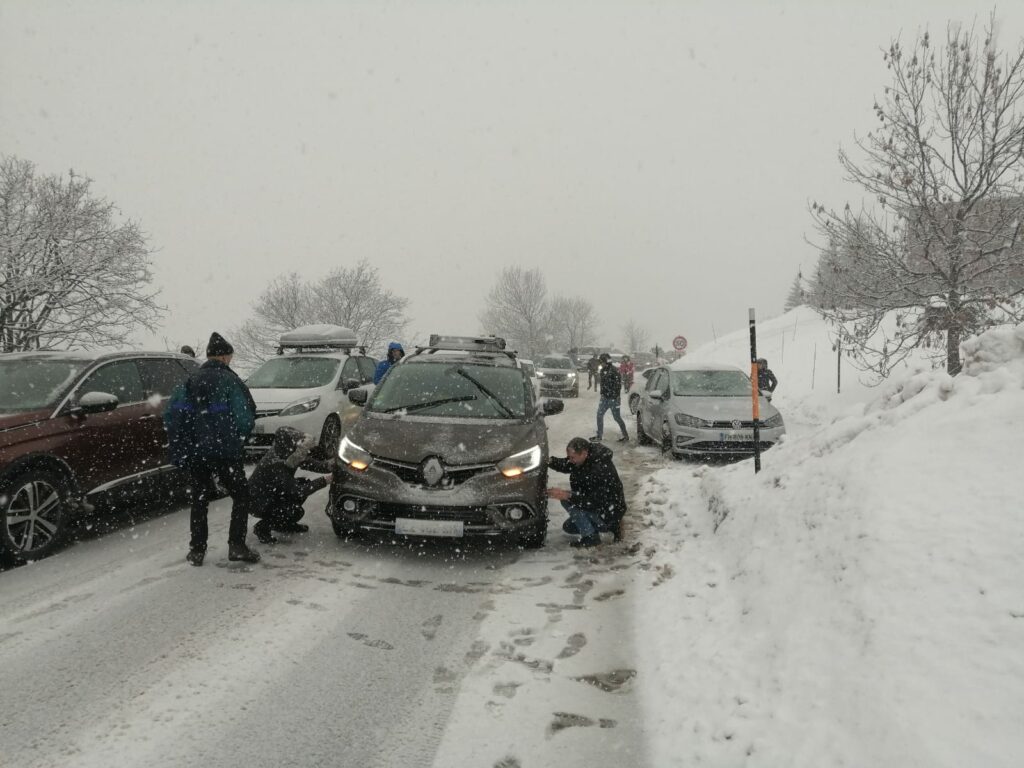
Fitting Your Chains: A Quick Guide
I would always get them on as soon as the road turned white in my two-wheel drives. Pull over safely, grab your head torch, gloves, and a mat to kneel on. Take your time and spread the chain out in front of you. Make sure there’s no snow packed behind the wheel, then get them on nice and straight.
Once you’re happy with the position on both wheels, drive the vehicle forward a bit to let them settle and loosen up. Then retighten. Drive forward a bit more, maybe 100 metres. If they’re not loose again, you’re all set. Nothing’s going to stop you now.
Practice Makes Perfect
Here’s the critical bit: get a decent set of chains that properly fit your wheels and tyres, then practise fitting them. Seriously, do several practice runs at home. Trust me on this—the first time you actually need them will be at 11 p.m. on a steep, snowy hill in freezing temperatures. That’s not when you want to discover your chains don’t fit or you can’t figure out how they work.
Snow Socks
Snow socks are technically approved by the authorities, but they have also advised against them. They stated that when the snow gets damp they have a tendency to slip. They’re inferior to proper chains in many conditions, particularly on ice. Chains are stronger, last longer, and handle serious snow better. Socks have lower traction limits and aren’t designed for extended use.
Our advice? Don’t risk it. Invest in a good set of snow chains and learn how to fit them properly. Your knuckles (and sanity) will thank you.
Other Legal Requirements
French law still requires you to carry safety equipment onboard your vehicle, mostly for breakdown situations. You’ll need a warning triangle and a reflective vest for each passenger. Non-negotiable.
(You might remember the breathalyser kit rule at one point—that was scrapped in 2020 as it had proved ineffective.)
Vignette/Toll Requirements
Most French motorways (autoroutes) are toll roads. You can choose to use credit card or cash at each toll, or I recommend you get a beeper, otherwise known as an electronic tag. It’s faster, and when the traffic gets heavy, the toll lanes for beepers/tags are always quicker.
Set up an account with one of several companies. I’m going to recommend Bip and Go and it’s in English: https://www.bipandgo.com/en/
You can also calculate the cost of your routes using this site: https://www.autoroutes.sanef.com/en/my-journey/price-of-my-journey
If you’re travelling through Switzerland and across the border, you’re going to need a Swiss vignette. This is an annual payment for the motorways there and can now be bought online. It used to be a sticker on the window but is now made simpler with registration of your number plate.
Purchase here: https://www.ch-vignette.com/en/
Route Planning & Conditions
Best Routes from Major Starting Points
From Calais/Channel Ports
The most direct route follows the A26 southward through Reims, then joins the A31 toward Dijon before picking up the A39/A40 toward Geneva and into the Alps. You’re looking at a hefty 1,000km to most major ski resorts—around 10-12 hours of straight driving in good conditions.
It’s worth building in an overnight stop. The last thing you want is to be tired when dealing with the last part of this journey as it’s the most hazardous. Take a rest. I tend to stop around Beaune, a lovely town with plenty of hotel options that makes for a pleasant break in the journey.
From Geneva Airport
This is our stomping ground. As a transfer operator, I know this part of the journey very well. Geneva is our most popular airport, and for good reason—it’s the most reliable option with the least congested routes on peak Saturdays.
As the closest major airport to many French ski resorts, Geneva offers excellent access via the A40 (Autoroute Blanche), which heads directly into the French Alps. You can reach Chamonix in 1-1.5 hours, Megève in about an hour, and the Tarentaise valley resorts such as Courchevel, Méribel, and Val d’Isère in around 3 hours.
From Lyon
Take the A43 toward Chambéry and the Maurienne valley to reach resorts like Val d’Isère and Tignes, or continue on the A430 for the Tarentaise valley. Lyon’s location makes it ideal for accessing both northern and southern French Alps destinations.
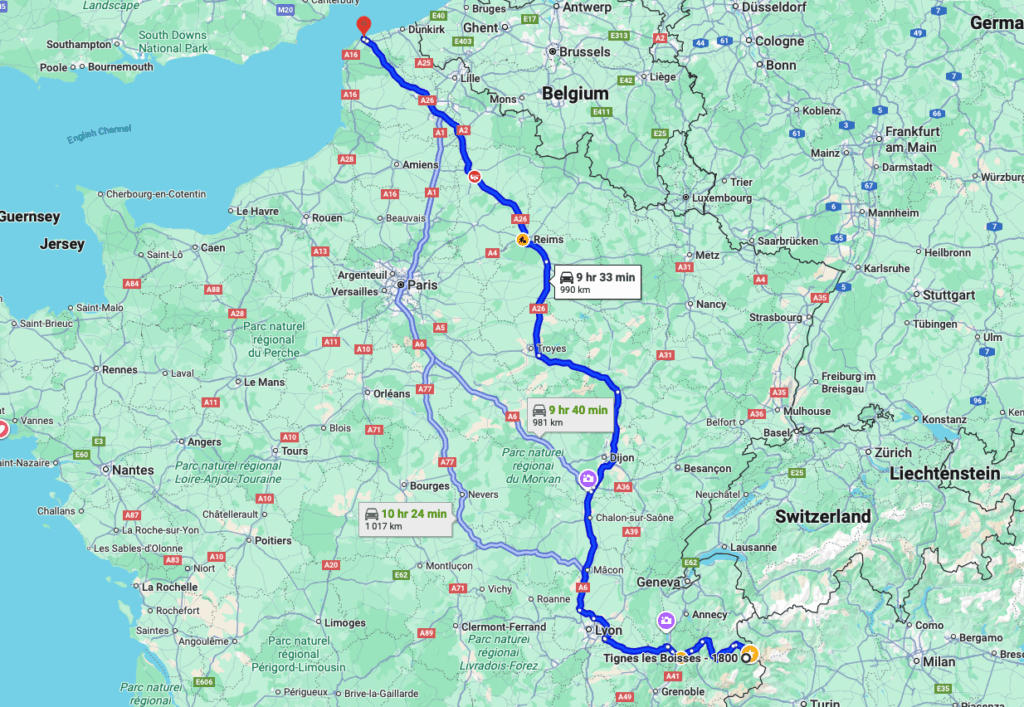
Mountain Pass Closures
It’s important to note that while these main routes stay open all winter, the high mountain passes close seasonally. Ensure you don’t plan a route that includes any of these: Col de l’Iseran, Col du Galibier, Col de la Madeleine, Petit-Saint-Bernard, and many others. Stick to the valley routes via the autoroutes, which remain open and maintained throughout the ski season.
The Saturday Traffic Challenge
I always tell our transfer customers traveling on Saturdays to arrive at and leave the resort first thing in the morning to avoid getting stuck in traffic—and I’d strongly advise you to do the same.
The route from Lyon onwards can get seriously congested. I mean really congested. People can get stuck for 7, 8, even 9 hours on occasion. The main culprit is the sheer volume of traffic coming in and out on Saturdays, all funnelled onto one main road that leads to the winding mountain passes.
The authorities have installed traffic control lights to prevent build-up on the mountain roads themselves, which is sensible from a safety perspective, but it creates significant tailbacks at the foot of the valley. The main road exits are closed off, so emergency services and local traffic can navigate using fluid back roads. Non-local traffic must sit it out on the A43 and N90. This is for safety, not just bloody-mindedness.
This is, I’m afraid, where using a local transfer company really comes into its own. We have local 73-registered plates, so we’re permitted to use the back roads when police close them to other traffic. Unfortunately, we regularly see kilometres upon kilometres of traffic backed up from Bourg-Saint-Maurice all the way past Albertville.
Bottom line: Get in and out early and you’ll avoid the worst of the congestion.
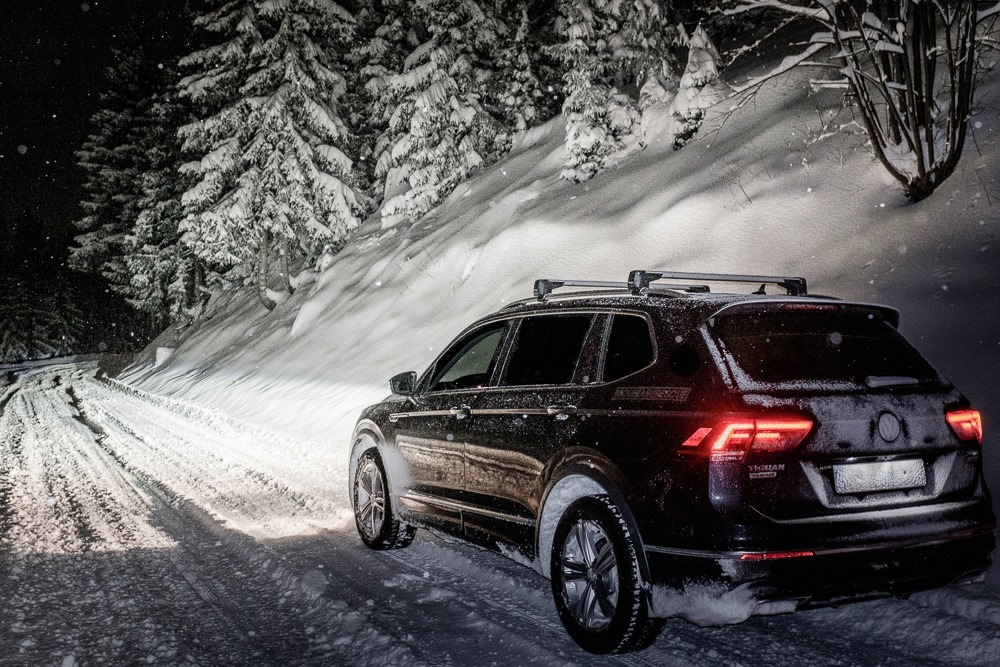
Best Time to Travel
Weekdays. I always tell my friends to come in the week. Sundays are much better than Saturdays, but weekdays are quiet around the mountains. Feel happy and smug—travel in and out during the week. We offer reduced prices for airport transfers on weekdays as the transfer times are always the fastest and with little hassle.
I’ve found this website handy for tracking road closures and traffic cams in the Savoie region: https://savoie-route.fr
Resort Parking
Think ahead here. Parking in some resorts can be tricky, especially during peak weeks. Expect to pay anything from €50 to €100 for a week’s parking. Make sure you go to your resort’s website and get yourself booked in well in advance.
It’s doubtful you’ll need your car whilst in resort, so utilise one of the underground parking locations and keep your car safe for your stay and warm. It’ll thank you for it. 😉
Alternative Travel Options
If this has put you off driving, here are a few alternative options for travelling to the French Alps this winter.
By Train
The French rail network is excellent and reaches close to many ski resorts. The TGV serves Moûtiers for access to the 3 Valleys, and Bourg-Saint-Maurice for Les Arcs, La Plagne, Sainte Foy, Val d’Isère, and Tignes.
Get the train to Bourg, but you will need to secure travel up to resort from there. There are some regular shuttle services, local taxi services, as well as ski transfer companies such as ourselves.
Eurostar also offers direct London-to-Alps (Bourg-Saint-Maurice) services on Saturdays during winter.
Key Benefits: No driving stress, can relax/sleep, no chain-fitting in snow, no parking costs, and more environmentally friendly.
Drawbacks: Less flexibility for arrival/departure times, need to coordinate luggage and ski equipment, may require additional transfers which can be expensive for families.
Car Hire with Winter Equipment
If flying to Geneva, Lyon, or Grenoble, hiring a car locally should ensure you get a vehicle with winter tyres already fitted. All rental companies in Alpine regions automatically equip cars with winter tyres during the season. Snow chains are usually available for a small additional fee (€10-20 per rental) or may be included. (All of the above problems are valid with a hire car.)
I would certainly check that at Lyon and Grenoble as they are not in the region where it’s required.
Private Transfer Companies
Finally, the plug. If you opt to fly and get a transfer, get in touch. Land in either Geneva, Lyon, Grenoble, or Chambéry airports and be met by one of our great driving team. We will meet you from your flight and take you directly to your accommodation in resort. We cover the entire Tarentaise Valley, which includes amazing resorts such as Les Arcs, La Plagne, Méribel, Courchevel, Val Thorens, Tignes, St Foy and Val d’Isère to name a few.
All our drivers are experienced, and most of them live here in the Alps. We only use 4×4 vehicles with premium snow tyres. This combination means we don’t need to use snow chains. Enjoy a smooth and comfortable journey to and from resort.
We track all our vehicles from our office and monitor flight and traffic conditions in real-time. Don’t worry about timings—that’s my job. I will let you know if you might be heading into some traffic and plan accordingly.
I hope this article helps people travelling to the French Alps. Please feel free to get in touch if you have any questions at all about travelling to this amazing part of the world.
Good luck and enjoy driving to the French Alps this winter!
Simon Wilkinson (Owner Mountain Rescue Transfers)
